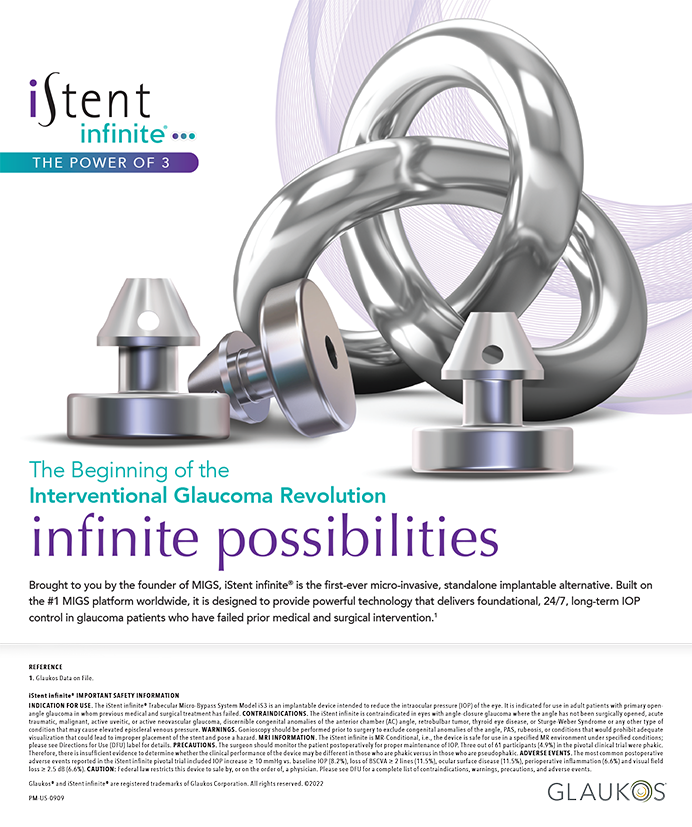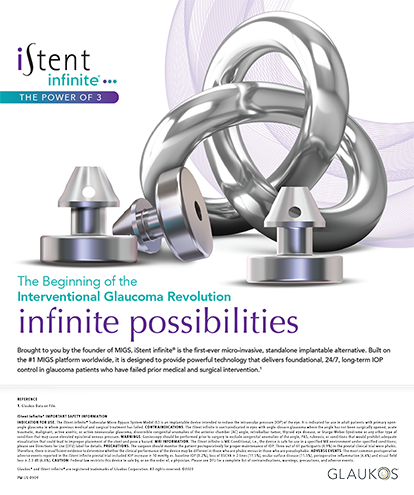During the past year, I have focused on refining my surgical outcomes with premium IOLs, improving conversion rates to premium lenses for the appropriate patients, better defining who will benefit the most from this technology, and using newer techniques in complicated cases. After transitioning to the Stellaris Vision Enhancement System (Bauch + Lomb, Rochester, NY), I have been able to decrease the incision’s size to 2.2 mm with no change in my coaxial phaco technique but a decrease in phaco time and overall surgical time per case. This article details other changes I have made.
OCULAR PATHOLOGY
Visual acuity results with presbyopia-correcting lenses, especially multifocal lenses, can be compromised by any pathology involving the ocular surface or cornea (eg, refractory dry eye, epithelial basement membrane dystrophy, and Fuchs’ corneal dystrophy). Even very mild cases warrant careful evaluation and may exclude the patient as a candidate for a multifocal lens. An elderly patient who may need laser vision correction to refine his or her refractive result after cataract surgery, with subsequent worsening of preexisting dry eye syndrome, can be difficult to manage postoperatively. I have also found that patients with early age-related macular degeneration, mild epiretinal membranes, or minimal nonproliferative diabetic retinopathy can do very well with these lenses and often have better-than-expected visual outcomes.
As a result, I now offer presbyopia-correcting lenses to patients with mild or early retinal diseases, but I caution them that, if their disease worsens, their vision will be affected no matter which lens they have selected.
TORIC IOLS
During the past year, my use of toric IOLs has increased considerably, and I have been very impressed with patients’ visual acuity and the rotational stability of these lenses. Precise centration and placement of the lens on the appropriate axis can be inexpensively accomplished by marking the cornea inside the limbus at the slit lamp with a cystotome dipped in marking ink and with the slit beam made very thin and tilted to the desired axis (many slit lamps are equipped with axis degree markings). The center of the undilated pupil and visual axis can also be marked at this time, if desired. These marks will remain visible for hours. Alternatively, Uday Devgan, MD, has developed a marking device produced by Accutome, Inc. (Malvern, PA), that fits on the slit lamp and will allow marking of the axis on the cornea with three dots that can then be lined up with the dots on the lens intraoperatively.
INTRAOPERATIVE FLOPPY IRIS SYNDROME
When operating on patients taking tamsulosin who have intraoperative floppy iris syndrome, I have found the following technique to be helpful. I begin by placing a Healon5 (Abbott Medical Optics Inc., Santa Ana, CA) “doughnut” in a single bead around the peripheral iris. I then fill the central portion of the anterior chamber with Viscoat (Alcon Laboratories, Inc., Forth Worth, TX) or another dispersive viscoelastic. I usually place the doughnut just before beginning phacoemulsification and replenish it if necessary just before beginning irrigation and aspiration. This method eliminates the need for iris hooks, pupillary expansion rings, or other such devices.
PSEUDOEXFOLIATION
Many patients with cataracts also present with pseudoexfoliation. In the past, I placed capsular tension rings in a large percentage of these cases when zonular weakness was evident intraoperatively. Now, I often implant an Akreos AO lens (Bausch + Lomb) without a capsular tension ring, because the IOL’s large optic and bulky footplate haptics distribute the zonular stresses in a similar fashion.
ALTERNATIVE FIXATION
When zonular support is absent and iris or scleral fixation is necessary, I have found that the technique described by Amar Agarwal, MD, and others works well and allows for precise centering of a three-piece lens. I externalize the IOL’s haptics, tuck them intrasclerally, and then glue or suture each haptic in place. When only one fixation point is needed for a dislocated lens, I usually suture the haptic to the iris instead, but it is helpful to have other techniques available as well.
The coming year will present many challenges, including uncertainties in reimbursement and escalating expectations of patients following refractive cataract surgery. My goal will be to continue to refine patient selection, outcomes, and techniques while improving efficiencies in my practice.
Cathleen M. McCabe, MD, practices at the Eye Associates in Bradenton, Florida. She is a speaker for Alcon Laboratories, Inc.; Bauch + Lomb; and Inspire Pharmaceuticals. Dr. McCabe may be reached at (941) 792-2020; cmccabe13@hotmail.com.


